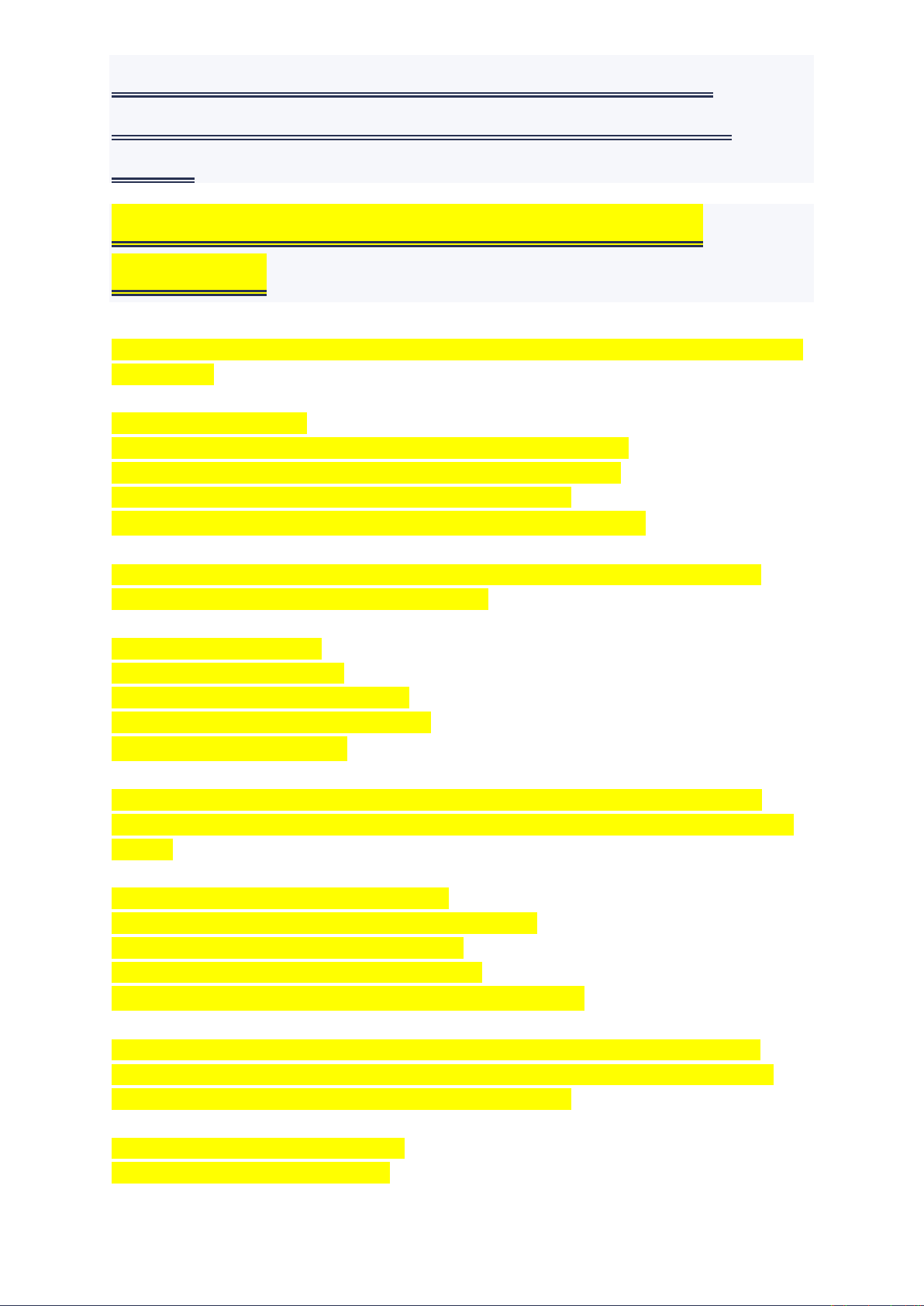
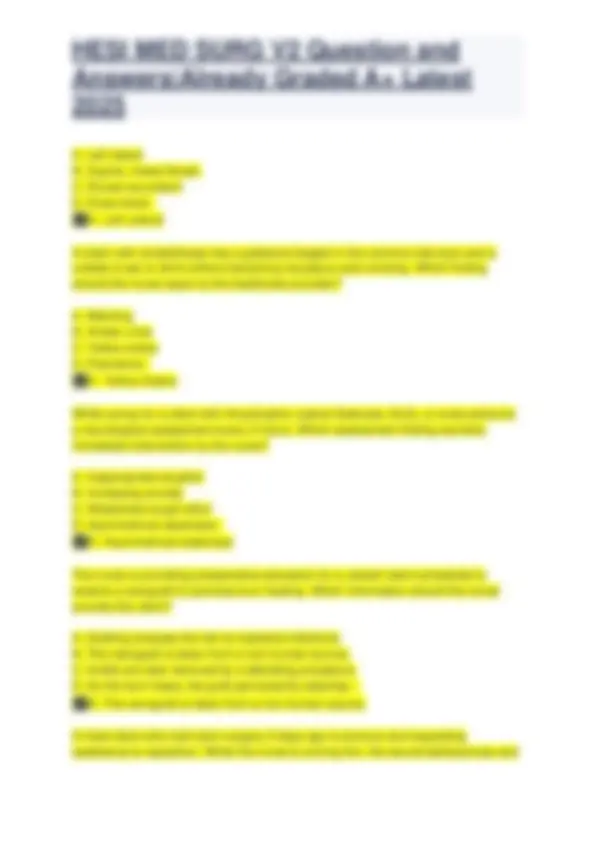
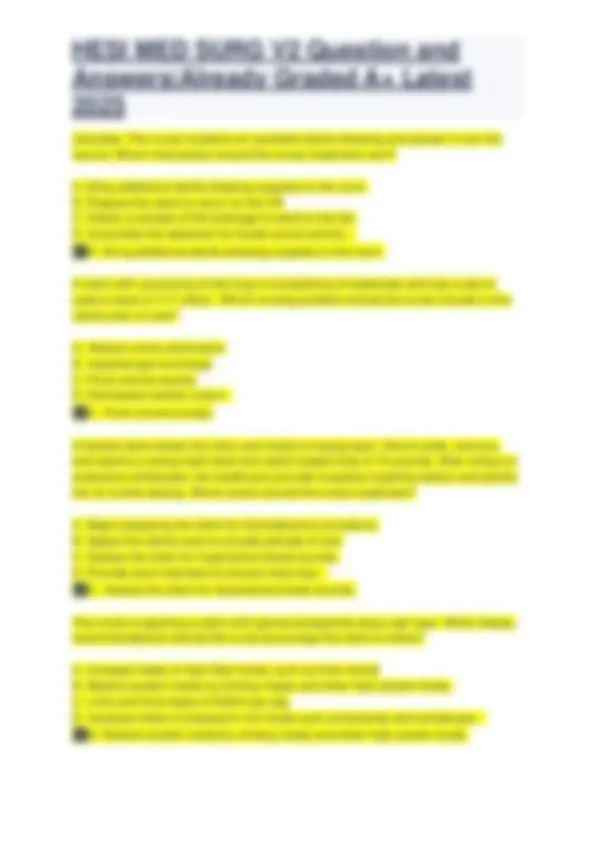
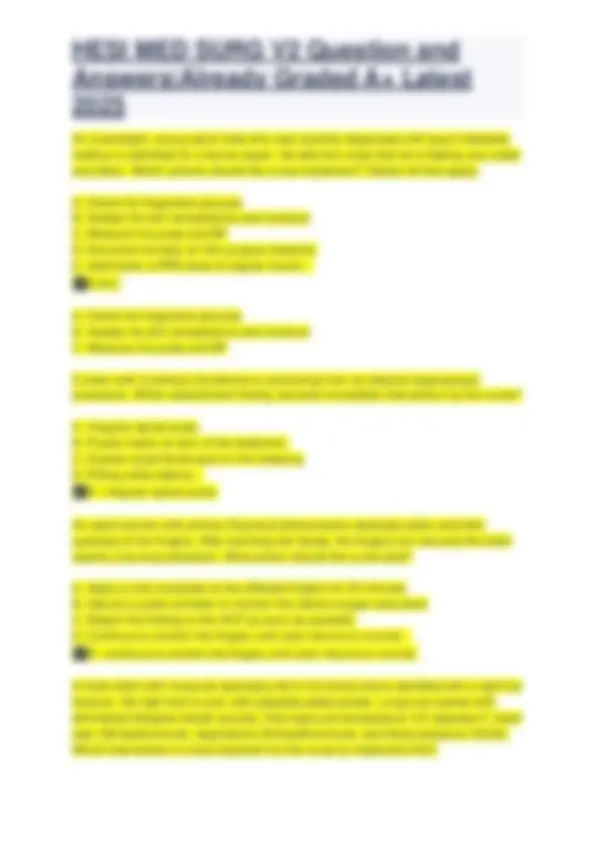
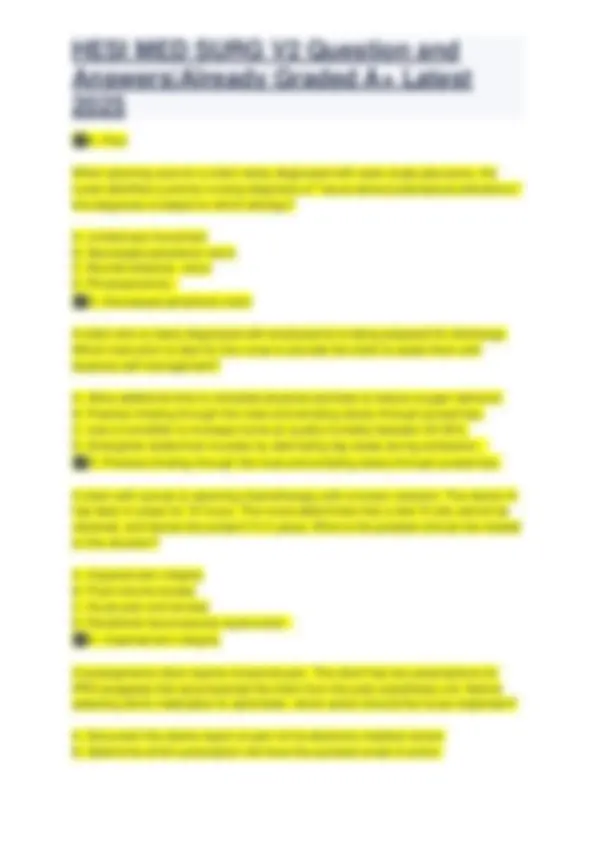
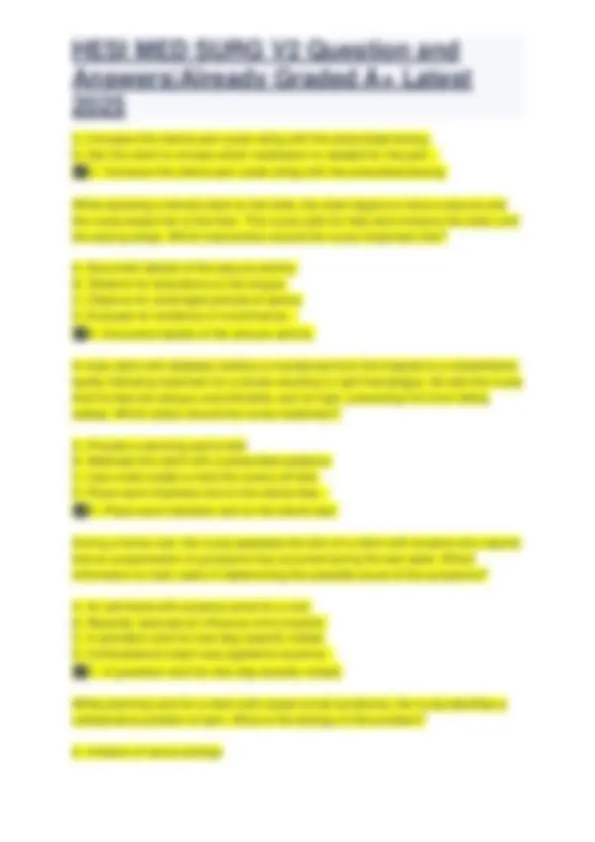
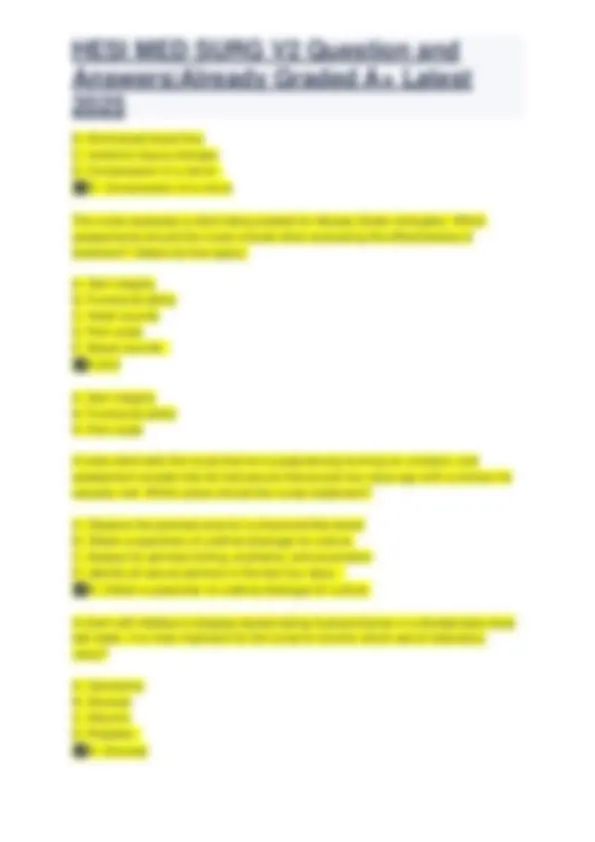
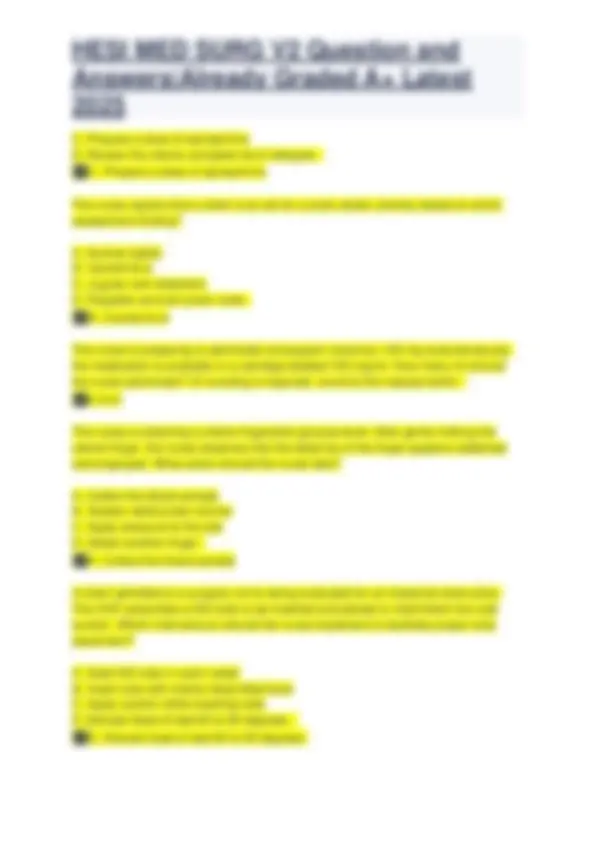
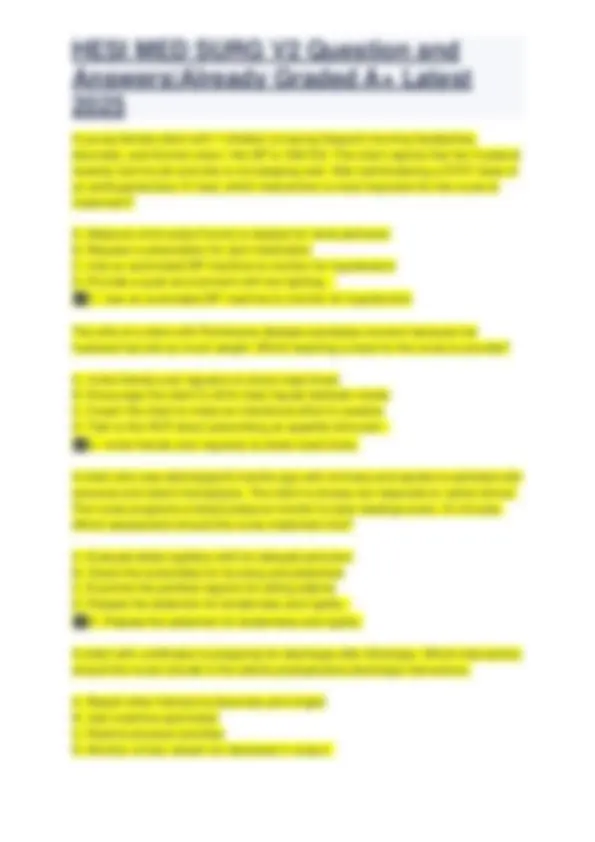



Study with the several resources on Docsity

Earn points by helping other students or get them with a premium plan


Prepare for your exams
Study with the several resources on Docsity

Earn points to download
Earn points by helping other students or get them with a premium plan
Community
Ask the community for help and clear up your study doubts
Discover the best universities in your country according to Docsity users
Free resources
Download our free guides on studying techniques, anxiety management strategies, and thesis advice from Docsity tutors
HESI MED SURG V2 Question and Answers Already Graded A+ Latest 2025.pdf
Typology: Exams
1 / 15

This page cannot be seen from the preview
Don't miss anything!










What Information should the nurse include in the teaching plan of a client diagnosed with GERD? A. Sleep without pillows B. Adjust food intake to three full meals per day with no snacks C. Minimize symptoms by wearing loose, comfortable clothing D. Avoid Participation in any aerobic exercise program - ✅C. Minimize symptoms by wearing loose, comfortable clothing After a hospitalization for SIADH, a client develops pontine myelinolysis. Which Intervention should the nurse implement first? A. Reorient client to room B. Place a patch on one eye C. Evaluate clients ability to swallow D. Perform range of motion exercises - ✅A. Reorient client to room A male client with heart failure calls the clinic and reports that he cannot put his shoes on because they are too tight. Which additional information should the nurse obtain? A. What time did he take his medication? B. Has his weight changed in the last several days? C. Is he still able to tighten his belt buckle? D. How many hours did he sleep last night? - ✅B. Has his weight changed over the last several days? An older adult woman with a long history of COPD is admitted with progressive shortness of breath and a persistent cough, is anxious, and is complaining of dry mouth. Which intervention should the nurse implement? A. Administer a prescribed sedative B. Encourage client to drink water
C. Apply a high flow venturi mask D. Assist her to an upright position - ✅D. Assist her to an upright position A client with a history of asthma and bronchitis arrives at the clinic with shortness of breath, productive cough with thickening mucous and the inability to walk up a flight of stairs without experiencing breathlessness. Which action is most important for the nurse to instruct the client about self care? A. Increase the daily intake of oral fluids to liquify secretions B. Avoid crowded enclosed areas to reduce pathogen exposure C. Call the clinic if undesirable side effects or medications occur D. Teach anxiety reduction methods for feelings of suffocation - ✅A. Increase the daily intake of oral fluids to liquify secretions A cardiac catheterization of a client with heart disease indicates the following blockages: 95% proximal left anterior descending (LAD), 99% proximal circumflex, and 95% proximal right coronary artery( RCA). The client later asks the nurse "What does all of that mean for me?" What information should the nurse provide? A. Blood supply to the heart is diminished by atherosclerotic lesions which necessitate life style changes. B. Blood vessels supplying the pumping chamber have blockages indicating a past heart attack. C. Three main arteries have major blockages, with only 1-5% of the blood flow getting through to the heart muscle D. The heart is not receiving enough blood, so there is a risk of heart failure and fluid retention - ✅C. Three main arteries have major blockages with only 1-5% of the blood flow getting through to the heart muscle A client who weighs 175 lbs is receiving an IV bolus dose of Heparin 80 units/kg. The Heparin is available in a 2 ml vial, labeled 10,000 units/ml. How many ml should the nurse administer? (enter numeric value only. If rounding is permitted, round to the nearest tenth) - ✅0.6ml The nurse is caring for a client with a lower left lobe pulmonary abscess. What position should the nurse instruct the client to maintain?
ulcerates. The nurse moistens an available sterile dressing and places it over the wound. Which intervention should the nurse implement next? A. Bring additional sterile dressing supplies to the room. B. Prepare the client to return to the OR C. Obtain a sample of the drainage to send to the lab. D. Auscultate the abdomen for bowel sound activity. - ✅A. Bring additional sterile dressing supplies to the room. A client with carcinoma of the lung is complaining of weakness and has a serum sodium level of 117 mEq/L. Which nursing problem should the nurse include in this clients plan of care? A. Altered urinary elimination B. Impaired gas exchange C. Fluid volume excess D. Decreased cardiac output - ✅C. Fluid volume excess A female client enters the clinic and insists on being seen. She is weak, nervous, and reports a racing heart beat and recent weight loss of 15 pounds. After ruling out substance withdrawal, the healthcare provider suspects hyperthyroidism and admits her for further testing. Which action should the nurse implement? A. Begin preparing the client for thyroidectomy procedure. B. Space the clients care to provide periods of rest. C. Assess the client for hyperactive bowel sounds. D. Provide warm blankets to prevent heat loss. - ✅C. Assess the client for hyperactive bowel sounds. The nurse is teaching a client with glomerulonephritis about self care. Which dietary recommendations should the nurse encourage the client to follow? A. Increase intake of high-fiber foods, such as bran cereal B. Restrict protein intake by limiting meats and other high-protein foods. C. Limit oral fluid intake of 500ml per day D. Increase intake of potassium rich foods such as bananas and cantaloupe. - ✅B. Restrict protein intake by limiting meats and other high-protein foods.
An overweight, young adult male who was recently diagnosed with type 2 diabetes mellitus is admitted for a hernia repair. He tells the nurse that he is feeling very weak and jittery. Which actions should the nurse implement? (Select all that apply) A. Check his fingerstick glucose B. Assess his skin temperature and moisture C. Measure his pulse and BP D. Document anxiety on the surgical checklist. E. Administer a PRN dose of regular insulin. - ✅A,B,C A. Check his fingerstick glucose B. Assess his skin temperature and moisture C. Measure his pulse and BP A client with Cushing's Syndrome is recovering from an elective laparoscopic procedure. Which assessment finding warrants immediate intervention by the nurse? A. Irregular apical pulse B. Purple marks on skin of the abdomen. C. Quarter sized blood spot on the dressing D. Pitting ankle edema. - ✅A. Irregular apical pulse. An adult woman with primary Raynaud phenomenon develops pallor and then cyanosis of her fingers. After warming her hands, the fingers turn red and the client reports a burning sensation. What action should the nurse take? A. Apply a cool compress to the affected fingers for 20 minutes B. Secure a pulse oximeter to monitor the clients oxygen saturation C. Report the finding to the HCP as soon as possible. D. Continue to monitor the fingers until color returns to normal. - ✅D. continue to monitor the fingers until color returns to normal. A male client with muscular dystrophy fell in his home and is admitted with a right hip fracture. His right foot is cool, with palpable pedal pulses. Lungs are coarse with diminished bibasilar breath sounds. Vital signs are temperature 101 degrees F, heart rate 128 beats/minute, respirations 28 breaths/minute, and blood pressure 122/82. Which intervention is most important for the nurse to implement first?
A. A 16 year old dark skinned female who tans in tanning beds once a week. B. A 65 year old fair skinned male who is a construction worker C. A 25 year old dark skinned male whose mother had skin cancer. D. A 70 year old fair skinned female who works as a a secretary. - ✅B. A 65 year old fair skinned male who is a construction worker. When caring for a client with nephrotic syndrome, which assessment is most important for the nurse to obtain? A. Daily weight B. Vital signs C. Level of consciousness D. Bowel sounds. - ✅A. Daily weight A female client who was involved in a motor vehicle collision is admitted with a fractured left femur which is immobilized using a fracture traction splint in preparation for an open reduction internal fixation( ORIF). The nurse determines that her distal pulses are diminished in the left foot. Which interventions should the nurse implement? (Select all that apply). A. Offer ice chips and oral clear liquids. B. Verify pedal pulses using a doppler pulse device. C. Monitor left leg for pain, pallor, paresthesia, paralysis, pressure. D. Evaluate the application of the splint to the left leg. E. Administer oral antispasmodics and narcotic analgesics. - ✅B,C,D B. Verify pedal pulses using a doppler pulse device C. Monitor left leg for pain, pallor, paresthesia, paralysis, pressure. D. Evaluate the application of the splint to the left leg. A male client with Herpes Zoster (shingles) on his thorax tells the nurse that he is having difficulty sleeping. What is the etiology of this problem? A. Pain B. Nocturia C. Dyspnea D. Frequent cough -
✅A. Pain When planning care for a client newly diagnosed with open angle glaucoma, the nurse identifies a priority nursing diagnosis of "visual sensory/perceptual alterations." this diagnosis is based on which etiology? A. Limited eye movement B. Decreased peripheral vision C. Blurred distance, vision D. Photosensitivity - ✅B. Decreased peripheral vision A client who is newly diagnosed with emphysema is being prepared for discharge. Which instruction is best for the nurse to provide the client to assist them with dyspnea self-management? A. Allow additional time to complete physical activities to reduce oxygen demand. B. Practice inhaling through the nose and exhaling slowly through pursed lips. C. Use a humidifier to increase home air quality humidity between 30-50%. D. Strengthen abdominal muscles by alternating leg raises during exhalation. - ✅B. Practice inhaling through the nose and exhaling slowly through pursed lips. A client with cancer is receiving chemotherapy with a known vesicant. The clients IV has been in place for 72 hours. The nurse determines that a new IV site cannot be obtained, and leaves the present IV in place. What is the greatest clinical risk related to this situation? A. Impaired skin integrity B. Fluid volume excess C. Acute pain and anxiety D. Peripheral neurovascular dysfunction - ✅A. Impaired skin integrity A postoperative client reports incisional pain. The client has two prescriptions for PRN analgesia that accompanied the client from the post-anesthesia unit. Before selecting which medication to administer, which action should the nurse implement? A. Document the clients report of pain int he electronic medical record. B. Determine which prescription will have the quickest onset of action.
B. Diminished blood flow C. Ischemic tissue changes D. Compression of a nerve - ✅D. Compression of a nerve The nurse assesses a client being treated for Herpes Zoster (shingles). Which assessments should the nurse include when evaluating the effectiveness of treatment? (Select all that apply). A. Skin integrity B. Functional ability C. Heart sounds D. Pain scale E. Bowel sounds - ✅A,B,D A. Skin integrity B. Functional ability D. Pain scale A male client tells the nurse that he is experiencing burning on urination, and assessment reveals that he had sexual intercourse four days ago with a woman he casually met. Which action should the nurse implement? A. Observe the perineal area for a chancroid-like lesion B. Obtain a specimen of urethral drainage for culture. C. Assess for perineal itching, erythema, and excoriation D. Identify all sexual partners in the last four days. - ✅B. Obtain a specimen of urethral drainage for culture. A client with Addison's disease started taking hydrocortisone in a divided daily dose last week. It is most important for the nurse to monitor which serum laboratory value? A. Osmolarity B. Glucose C. Albumin D. Platelets - ✅B. Glucose
A client with AIDS has impaired gas exchange from a respiratory infection. Which assessment finding warrants immediate intervention by the nurse? A. Elevated temperature B. Generalized weakness C. Diminished lung sounds D. Pain when swallowing - ✅D. Pain when swallowing An older male client tells the nurse that he is losing sleep because he has to get up several times at night to go to the bathroom, that he has trouble starting his urinary stream, and that he does not fell like his bladder is ever completely empty. Which intervention should the nurse implement? A. Collect a urine specimen for culture analysis B. Review the clients fluid intake prior to bedtime C. Palpate the bladder above the symphysis pubis. D. Obtain a fingerstick glucose level. - ✅C. Palpate the bladder above the symphysis pubis. Fluids are restricted to 1500 ml/day for a male client with AKI. He is frustrated and complaining of constant thirst, and the nurse discovers that the family is providing the client with additional fluids. What intervention should the nurse implement? A. Remove all sources of liquids from the clients room B. Allow family to give the client a measured amount of ice chips C. Restrict family visiting until the clients condition is stable D. Provide the client with oral swabs to moisten his mouth. - ✅D. Provide the client with oral swabs to moisten his mouth During a paracentesis, two liters of fluid are removed from the abdomen of a client with ascites. A drainage bag is placed, and 50 ml of straw colored fluid drains within the first hour. What action should the nurse implement? A. Palpate for abdominal distention B. Send fluid to the lab for analysis C. Continue to monitor the fluid output D. Clamp drainage tube for 5 minutes -
C. Prepare a dose of epinephrine D. Review the clients complete list of allergies - ✅C. Prepare a dose of epinephrine The nurse reports that a client is at risk for a brain attack (stroke) based on which assessment finding? A. Nuchal rigidity B. Carotid bruit C. Jugular vein distention D. Palpable cervical lymph node - ✅B. Carotid bruit The nurse is preparing to administer enoxaparin (lovenox) 135 mg subcutaneously. the medication is available in a cartridge labeled 150 mg/ml. How many ml should the nurse administer? (if rounding is required, round to the nearest tenth) - ✅0.9 ml The nurse is obtaining a clients fingerstick glucose level. After gently milking the clients finger, the nurse observes that the distal tip of the finger appears reddened and engorged. What action should the nurse take? A. Collect the blood sample B. Assess radial pulse volume C. Apply pressure to the site D. Select another finger - ✅A. Collect the blood sample A client admitted to a surgical unit is being evaluated for an intestinal obstruction. The HCP prescribes a NG tube to be inserted and placed to intermittent low wall suction. Which interventuon should the nurse implement to facilitate proper tube placement? A. Soak NG tube in warm water B. Insert tube with clients head tilted back C. Apply suction while inserting tube D. Elevate head of bed 60 to 90 degrees. - ✅D. Elevate head of bed 60 to 90 degrees.
A young female client with 7 children is having frequent morning headaches, dizziness, and blurred vision. Her BP is 168/104. The client reports that her husband recently lost his job and she is not sleeping well. After administering a STAT dose of an antihypertensive IV med, which intervention is most important for the nurse to implement? A. Measure urine output hourly to assess for renal perfusion B. Request a prescription for pain medication C. Use an automated BP machine to monitor for hypotension D. Provide a quiet environment with low lighting. - ✅C. Use an automated BP machine to monitor for hypotension The wife of a client with Parkinsons disease expresses concern because her husband has lost so much weight. Which teaching is best for the nurse to provide? A. Invite friends over regularly to share meal times B. Encourage the client to drink clear liquids between meals C. Coach the client to make an intentional effort to swallow D. Talk to the HCP about prescribing an appetite stimulant - ✅A. Invite friends over regularly to share meal times. A client who was discharged 8 months ago with cirrhosis and ascites is admitted with anorexia and recent hemoptysis. The client is drowsy but responds to verbal stimuli. The nurse programs a blood pressure monitor to take readings every 15 minutes. Which assessment should the nurse implement first? A. Evaluate distal capillary refill for delayed perfusion B. Check the extremities for bruising and petechiae C. Examine the pertibial regions for pitting edema D. Palpate the abdomen for tenderness and rigidity - ✅D. Palpate the abdomen for tenderness and rigidity. A client with urolithiasis is preparing for discharge after lithotripsy. Which intervention should the nurse include in the clients postoperative discharge instructions. A. Report when hematuria becomes pink tinged B. Use incentive spirometer C. Restrict physical activities D. Monitor urinary stream for decrease in output -